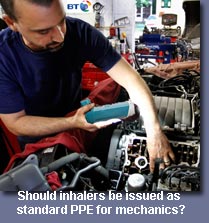 |
|
Motor Vehicle Repair Bodyshop Workers Still At Risk Of Asthma
Body shop workers are being encouraged to do more to protect themselves when paint spraying, as new research suggests that some are still putting themselves at risk of developing asthma.
 A report by the Health and Safety Executive (HSE) into the use of two-pack paints containing isocyanates has identified that, while practices have improved greatly in recent years, there are still a number of areas of concern. A report by the Health and Safety Executive (HSE) into the use of two-pack paints containing isocyanates has identified that, while practices have improved greatly in recent years, there are still a number of areas of concern.
HSE estimates that vehicle spray painters are 80 times more likely to develop occupational asthma than the average worker in the UK because they fail to take the correct precautions.
Visits to 30 motor vehicle repair bodyshops and telephone surveys with 500 bodyshops found some sprayers and managers remain unaware of the link between breathing in isocyanates contained within the invisible spray mist, and developing occupational asthma.
Almost one in five bodyshop managers surveyed by telephone did not know their booth clearance times. This, combined with the finding that many sprayers are still unaware of the dangers of invisible spray mist puts workers at risk of re-entering booths too soon, making them more vulnerable to breathing in isocyanates.
Encouragingly, the study found that the vast majority of sprayers (85 per cent) do wear air-fed breathing apparatus. However, many continue to put their health at risk by lifting their visors to check the finish before the paint is dry, potentially exposing themselves to the isocyanate-containing mist.
Louise Rice from HSE said:
"We're encouraged to see that body shop managers and sprayers are generally much more aware of the risks of isocyanates and what they need to do to protect themselves, but it is worrying that the message is still not getting through to all of them.
Occupational asthma destroys careers and lives. We appreciate that sprayers work to tight deadlines and time pressures, but they should not be gambling with their health. We will use this research to ensure we're working with industry in the most effective way to help reduce the risk to workers."
The research also considered how factors such as size of business, working hours and bonus systems, health surveillance, personal protective equipment and training impact on health and safety practices in isocyanate paint use.
Anyone with ideas and suggestions for how the motor vehicle repair industry can further improve practices can email HSE at MVR@hse.gsi.gov.uk
Source: HSE
|
|
|
Designed, Hosted and Maintained by Union Safety Services
|


 A report by the Health and Safety Executive (HSE) into the use of two-pack paints containing isocyanates has identified that, while practices have improved greatly in recent years, there are still a number of areas of concern.
A report by the Health and Safety Executive (HSE) into the use of two-pack paints containing isocyanates has identified that, while practices have improved greatly in recent years, there are still a number of areas of concern.